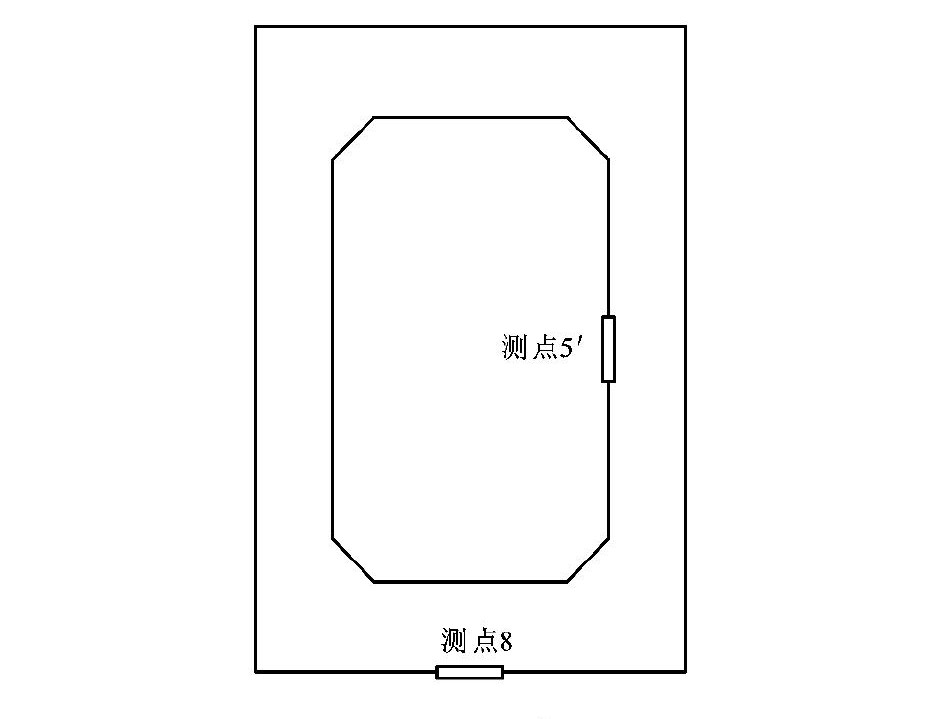Temperature effects of H-shaped concrete pylon in arctic-alpine plateau region
-
摘要: 分析了混凝土结构温度场边界条件计算方法, 以青海省海黄大桥H形混凝土桥塔为工程背景, 计算了高原高寒地区四季典型气象条件下的桥塔温度场分布, 对比了四季的桥塔表面温差和塔壁局部温差, 确定了桥塔的最不利温度荷载, 建立了桥塔整体有限元模型, 分析了四季桥塔的偏位、竖向应力、横向应力和纵向应力等温度效应。分析结果表明: 桥塔表面温差与桥塔局部温差均在冬季最大, 最大值分别可达11.88℃、20.79℃, 在夏季最小, 最大值分别可达5.15℃、15.25℃; 横桥向和纵桥向桥塔表面温差最大值分别达到9.15℃、11.88℃, 远大于《公路斜拉桥设计细则》 (JTG/T D65-01—2007) 推荐值±5℃; 接近正南方向的塔壁局部温差最大, 沿壁厚方向的温差分布接近指数形式, 冬季和夏季温度衰减系数最大值分别为4.50、5.01, 故冬季桥塔壁板局部温度分布较夏季更不均匀; 桥塔温度效应同样在冬季最大, 1天中最大桥塔偏位超过40mm, 白天桥塔偏位变化值超过15mm, 不利于施工过程中的桥塔偏位监测; 桥塔根部竖向最大拉应力达到2.2MPa, 桥塔根部同样产生较大水平向拉应力, 纵桥向和横桥向最大拉应力分别为1.82、0.82 MPa, 均发生在桥塔内侧, 在与其他作用组合时可能会造成桥塔开裂, 建议在桥塔塔壁内侧布置一定量的钢筋网片来控制裂缝; 在进行高原高寒地区桥塔设计和施工控制时, 应充分考虑温度效应带来的不利影响。Abstract: The boundary condition calculation method of concrete structure temperature field was analyzed. The H-shaped concrete pylon of Haihuang Bridge in Qinghai Province was taken as engineering background, and the temperature field distributions of pylon under typical meteorological conditions during all seasons in arctic-alpine plateau region were calculated. The temperature differences between pylon surfaces and parts of tower wall in all seasons were compared, and the most adverse temperature load of pylon was determined. The whole finite element model of pylon was established, the temperature effects of pylon such as the displacements, vertical stresses, horizontal stresses and longitudinal stresses in all seasons were analyzed. Analysis result shows that the temperature differences of surface and local of pylon reach maximum in winter, and the maximum values are 11.88 ℃ and 20.79 ℃, respectively. The temperature differences reach minimum in summer, and the maximum values are 5.15 ℃ and 15.25 ℃, respectively. The maximum transverse and longitudinal temperature differences of pylon surface are 9.15 ℃ and 11.88 ℃, respectively, and are much larger than ±5 ℃ recommended in Guidelines for Design of Highway Cable-stayed Bridge (JTG/T D65-01—2007). The local temperature difference of tower wall near the south direction is largest, and the temperature difference distribution along thickness direction is close to exponential form. The maximum temperature attenuation coefficient is 4.50 in winter and 5.01 in summer, so the local temperature distribution of pylon wallboard in winter is more nonuniform than in summer. The maximum thermal effect also appears in winter, the maximal displacement of pylon is more than 40 mm in a day, and the variation value of displacement is more than 15 mm during daytime, which is adverse to monitoring pylon displacement in construction. The maximum vertical tension stress of pylon root reaches 2.2 MPa, pylon root also has large horizontal tensile stresses, the maximum longitudinal and transverse tension stresses are 1.82 and 0.82 MPa, respectively, and both occur inside pylon. When the tensile stresses combined with other actions may cause pylon cracks, so a certain amount of reinforced net should be arranged inside pylon wall to control the cracks. In the design and construction control of pylon in arctic-alpine plateau region, the adverse temperature effects should be considered.
-
表 1 四季典型气象参数
Table 1. Typical meteorological parameters in 4seasons

表 2 材料热工参数
Table 2. Thermal parameters of materials

表 3 四季桥塔表面最大温差
Table 3. Maximum temperature differences of pylon surfaces in 4seasons

表 4 四季塔壁局部温差参数
Table 4. Parameters of local pylon wall temperature difference in 4seasons

-
[1] 唐红元. 斜拉桥预应力混凝土索塔关键问题研究[D]. 南京: 东南大学, 2006.TANG Hong-yuan. Study on key problems of cable-stayed bridge PC pylon[D]. Nanjing: Southeast University, 2006. (in Chinese). [2] FENG Zhong-ren, SHEN Jian, WANG Xiong-jiang. Finite element analysis of thermal stress for cable-stayed bridge tower with cracks[J]. Applied Mechanics and Materials, 2012, 178-181: 2085-2090. doi: 10.4028/www.scientific.net/AMM.178-181.2085 [3] 任翔, 佟阳, 何青, 等. 薄壁箱形混凝土桥塔温度应力场分析[J]. 广西大学学报: 自然科学版, 2011, 36 (1): 121-127. doi: 10.3969/j.issn.1001-7445.2011.01.019REN Xiang, TONG Yang, HE Qing, et al. Thermal stress fields of thin-walled box girder concrete bridge tower[J]. Journal of Guangxi University: Natural Science Edition, 2011, 36 (1): 121-127. (in Chinese). doi: 10.3969/j.issn.1001-7445.2011.01.019 [4] 任翔, 何青, 佟阳, 等. 混凝土桥塔温度场和空间应力场分析[J]. 郑州大学学报: 工学版, 2011, 32 (2): 62-65. doi: 10.3969/j.issn.1671-6833.2011.02.016REN Xiang, HE Qing, TONG Yang, et al. Temperature andstress fields analysis of concrete bridge tower[J]. Journal of Zhengzhou University: Engineering Science, 2011, 32 (2): 62-65. (in Chinese). doi: 10.3969/j.issn.1671-6833.2011.02.016 [5] 谢尚英. 广州猎德大桥索塔日照温度效应分析[J]. 桥梁建设, 2007 (2): 72-75. doi: 10.3969/j.issn.1003-4722.2007.02.020XIE Shang-ying. Analysis of sunshine temperature effect on tower of Liede Bridge in Guangzhou[J]. Bridge Construction, 2007 (2): 72-75. (in Chinese). doi: 10.3969/j.issn.1003-4722.2007.02.020 [6] 靳敏超, 冯仲仁, 刘吉波, 等. 斜拉桥索塔裂缝的温变特性研究[J]. 公路, 2010 (1): 39-42. doi: 10.3969/j.issn.1002-0268.2010.01.008JIN Min-chao, FENG Zhong-ren, LIU Ji-bo, et al. A study on temperature variation characteristics of tower cracks of cable-stayed bridge[J]. Highway, 2010 (1): 39-42. (in Chinese). doi: 10.3969/j.issn.1002-0268.2010.01.008 [7] 樊启武, 钱永久. 采用间接耦合法分析斜拉桥索塔瞬态温度应力场[J]. 石家庄铁道大学学报: 自然科学版, 2008, 21 (1): 18-22. doi: 10.3969/j.issn.2095-0373.2008.01.004FAN Qi-wu, QIAN Yong-jiu. Analysis of transient temperature gradient and thermal stress field of cable-stayed bridge tower by means of indirect coupling[J]. Journal of Shijiazhuang Railway Institute: Natural Science, 2008, 21 (1): 18-22. (in Chinese). doi: 10.3969/j.issn.2095-0373.2008.01.004 [8] 吕文江, 李永利, 解瑞松, 等. 超高薄壁空心高墩的温度效应研究[J]. 公路交通科技: 应用技术版, 2014 (11): 13-15. https://www.cnki.com.cn/Article/CJFDTOTAL-GLJJ201411006.htmLU Wen-jiang, LI Yong-li, XIE Rui-song, et al. Study on temperature effect of super-high thin-walled hollow high pier[J]. Journal of Highway and Transportation Research and Development: Application and Technology, 2014 (11): 13-15. (in Chinese). https://www.cnki.com.cn/Article/CJFDTOTAL-GLJJ201411006.htm [9] 武立群. 混凝土箱梁和空心高墩温度场及温度效应研究[D]. 重庆: 重庆大学, 2012.WU Li-qun. Analysis of temperature field and temperature effects for concrete box girder and hollow high pier[D]. Chongqing: Chongqing University, 2012. (in Chinese). [10] 代璞, 钱永久. 斜拉桥H形截面混凝土桥塔短期温度特性[J]. 西南交通大学学报, 2014, 49 (1): 59-65. https://www.cnki.com.cn/Article/CJFDTOTAL-XNJT201401011.htmDAI Pu, QIAN Yong-jiu. Short-term temperature characteristics of H-shaped section concrete pylon of cablestayed bridge[J]. Journal of Southwest Jiaotong University, 2014, 49 (1): 59-65. (in Chinese). https://www.cnki.com.cn/Article/CJFDTOTAL-XNJT201401011.htm [11] 孙增智, 田俊壮, 石强, 等. 承台大体积混凝土里表温差梯度与温差应力有限元模拟[J]. 交通运输工程学报, 2016, 16 (2): 18-26, 36. http://transport.chd.edu.cn/article/id/201602003SUN Zeng-zhi, TIAN Jun-zhuang, SHI Qiang, et al. Finite element simulation of inside-outside temperature gradient and thermal stress for abutment mass concrete[J]. Journal of Traffic and Transportation Engineering, 2016, 16 (2): 18-26, 36. (in Chinese). http://transport.chd.edu.cn/article/id/201602003 [12] 王鹏, 王福敏, 李琦, 等. 环境降温对斜拉桥混凝土主塔早期开裂影响研究[J]. 特种结构, 2010, 27 (2): 66-70. https://www.cnki.com.cn/Article/CJFDTOTAL-TZJG201002023.htmWANG Peng, WANG Fu-min, LI Qi, et al. Effect study of environment cooling on early-age cracking in concrete tower of cable-stayed bridge[J]. Special Structures, 2010, 27 (2): 66-70. (in Chinese). https://www.cnki.com.cn/Article/CJFDTOTAL-TZJG201002023.htm [13] ZHANG Hai-long, LI Jun, LIU Chang-guo, et al. Thermal effect of the cable-stayed bridge tower[J]. Wuhan University Journal of Natural Sciences, 2003, 8 (4): 1121-1125. [14] DILGER W H, GHALI A, CHAN M, et al. Temperature stresses in composite box girder bridges[J]. Journal of Structural Engineering, 1983, 109 (6): 1460-1478. [15] 向学建, 董军, 刘昊苏, 等. 高原冬季环境下桥梁温度场各参数的确定[J]. 公路交通科技, 2012, 29 (3): 58-63, 85. https://www.cnki.com.cn/Article/CJFDTOTAL-GLJK201203010.htmXIANG Xue-jian, DONG Jun, LIU Hao-su, et al. Determination of parameters of temperature field of boxgirder bridge in winter weather of plateau[J]. Journal of Highway and Transportation Research and Development, 2012, 29 (3): 58-63, 85. (in Chinese). https://www.cnki.com.cn/Article/CJFDTOTAL-GLJK201203010.htm [16] 赵人达, 王永宝. 日照作用下混凝土箱梁温度场边界条件研究[J]. 中国公路学报, 2016, 29 (7): 52-61. https://www.cnki.com.cn/Article/CJFDTOTAL-ZGGL201607009.htmZHAO Ren-da, WANG Yong-bao. Studies on temperature field boundary conditions for concrete box-girder bridges under solar radiation[J]. China Journal of Highway and Transport, 2016, 29 (7): 52-61. (in Chinese). https://www.cnki.com.cn/Article/CJFDTOTAL-ZGGL201607009.htm [17] LEE Jong-han. Investigation of extreme environmental conditions and design thermal gradients during construction for prestressed concrete bridge girders[J]. Journal of Bridge Engineering, 2012, 17 (3): 547-556. [18] 蒋国富. 大跨径桥梁高墩日照温度效应的研究[D]. 西安: 长安大学, 2005.JIANG Guo-fu. The study of sunlight temperature effect for high pier of long-span bridge[D]. Xi'an: Chang'an University, 2005. (in Chinese). [19] 吴继臣, 徐刚. 全国主要城市冬季太阳辐射强度的研究[J]. 哈尔滨工业大学学报, 2003, 35 (10): 1236-1239. https://www.cnki.com.cn/Article/CJFDTOTAL-HEBX200310024.htmWU Ji-chen, XU Gang. Major Chinese cities'solar radiant intensities in winter[J]. Journal of Harbin Institute of Technology, 2003, 35 (10): 1236-1239. (in Chinese). https://www.cnki.com.cn/Article/CJFDTOTAL-HEBX200310024.htm [20] 周德云, 林元培. 斜拉桥温度影响分析方法[J]. 华东公路, 1990 (4): 42-48.ZHOU De-yun, LIN Yuan-pei. Temperature effect analysis method of cable-stayed bridge[J]. East China Highway, 1990 (4): 42-48. (in Chinese). [21] KIM S H, PARK S J, WU Jia-xu, et al. Temperature variation in steel box girders of cable-stayed bridges during construction[J]. Journal of Constructional Steel Research, 2015, 112: 80-92. [22] 张建荣, 徐向东, 刘文燕. 混凝土表面太阳辐射吸收系数测试研究[J]. 建筑科学, 2006, 22 (1): 42-45. https://www.cnki.com.cn/Article/CJFDTOTAL-JZKX200601009.htmZHANG Jian-rong, XU Xiang-dong, LIU Wen-yan. A test study on the solar radiation absorption coefficient of concrete surface[J]. Building Science, 2006, 22 (1): 42-45. (in Chinese). https://www.cnki.com.cn/Article/CJFDTOTAL-JZKX200601009.htm [23] 顾斌, 陈志坚, 陈欣迪. 基于气象参数的混凝土箱梁日照温度场仿真分析[J]. 东南大学学报: 自然科学版, 2012, 42 (5): 950-955. https://www.cnki.com.cn/Article/CJFDTOTAL-DNDX201205029.htmGU Bin, CHEN Zhi-jian, CHEN Xin-di. Simulation analysis for solar temperature field of concrete box girder based on meteorological parameters[J]. Journal of Southeast University: Natural Science Edition, 2012, 42 (5): 950-955. (in Chinese). https://www.cnki.com.cn/Article/CJFDTOTAL-DNDX201205029.htm [24] ROBERTS-WOLLMAN C L, BREEN J E, CAWRSE J. Measurements of thermal gradients and their effects on segmental concrete bridge[J]. Journal of Bridge Engineering, 2002, 7 (3): 166-174. [25] 张运波. 薄壁空心高墩的温度效应及其对稳定性影响的研究[D]. 北京: 中国铁道科学研究院, 2011.ZHANG Yun-bo. Studies on temperature effects and its influence on stability for high pier with thin-walled hollow sections[D]. Beijing: China Academy of Railway Sciences, 2011. (in Chinese). [26] 文永蓬, 徐小峻, 尚慧琳, 等. 考虑热力耦合的轨道车辆车轮建模与仿真[J]. 交通运输工程学报, 2016, 16 (5): 30-41. http://transport.chd.edu.cn/article/id/201605004WEN Yong-peng, XU Xiao-jun, SHANG Hui-lin, et al. Modeling and simulation of railway vehicle wheel considering thermo-mechanical coupling[J]. Journal of Traffic and Transportation Engineering, 2016, 16 (5): 30-41. (in Chinese). http://transport.chd.edu.cn/article/id/201605004 -





 下载:
下载:
























